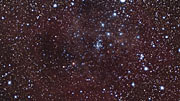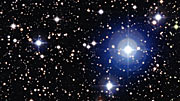Komunikat prasowy
Młode, gorące i niebieskie
Gwiazdy w gromadzie NGC 2547
27 marca 2013
Te ładnie świecące na niebiesko gwiazdy to gromada NGC 2547, grupa niedawno powstałych gwiazd w południowym gwiazdozbiorze Żagla. Zdjęcie wykonano za pomocą instrumentu Wide Field Imager na 2,2-metrowym teleskopie MPG/ESO w Obserwatorium ESO La Silla w Chile.
Wszechświat to dość stara okolica – ma w przybliżeniu 13,8 miliarda lat. Nasza galaktyka, Droga Mleczna, także jest stara – niektóre z jej gwiazd liczą sobie ponad 13 miliardów lat (eso0425). Mimo tego nadal wiele się dzieje: powstają nowe obiekty, a inne są niszczone. Na zaprezentowanym zdjęciu można zobaczyć nowych przybyszów, młode gwiazdy tworzące gromadę NGC 2547,
Ale na ile młoda jest w rzeczywistości ta gwiezdna młodzież? Mimo, że ich dokładny wiek jest niepewny, astronomowie szacują, że gwiazdy NGC 2547 mają od 20 do 35 milionów lat. Nie wydaje to się wcale mało. Jednak nasze Słońce ma 4,6 miliarda lat i nie osiągnęło jeszcze wieku średniego. Gdybyśmy sobie wyobrazili, że Słońce jest czterdziestoletnią osobą, to jasne gwiazdy na zdjęciu byłyby trzymiesięcznymi niemowlętami.
Większość gwiazd nie powstaje samotnie, ale w bogatych gromadach liczących od kilkudziesięciu do kilku tysięcy obiektów. O ile NGC 2547 zawiera wiele gorących gwiazd, które świecą na niebiesko, co jest oznaką ich młodości, można także dostrzec jedną lub dwie żółte lub czerwone gwiazdy, które już wyewoluowały do czerwonych olbrzymów. Gromady otwarte takie jak ta zwykle mają względnie krótkie życie, rzędu kilkuset milionów lat, zanim zanikną, gdy ich obiekty składowe rozproszą się w przestrzeni.
Gromady są kluczowymi obiektami dla astronomów badających w jaki sposób gwiazdy ewoluują w trakcie swojego życia. Członkinie gromady wszystkie powstały z tej samej materii, mniej więcej w tym samym czasie, co ułatwia wyznaczenie innych ich własności.
Gromada gwiazd NGC 2547 widoczna jest w południowym gwiazdozbiorze Żagla, znajduje się około 1500 lat świetlnych od Ziemi i jest na tyle jasna, że łatwo ją dostrzec przez lornetkę. Została odkryta w 1751 roku przez francuskiego astronoma Nicolasa-Louisa de Lacaille’a podczas astronomicznej wyprawny na Przylądek Dobrej Nadziei w Afryce Południowej. Używał on niewielkiego teleskopu o aperturze mniejszej niż dwa centymetry.
Pomiędzy jasnymi gwiazdami na zdjęciu można dostrzec wiele innych obiektów, szczególnie gdy fotografię powiększymy. Wiele z nich to słabsze lub bardziej odległe gwiazdy Drogi Mlecznej, ale część, wyglądających jak rozciągłe mgiełki, to galaktyki, położone miliony lat świetlnych dalej niż gwiazdy ze zdjęcia.
Kontakt
Richard Hook
ESO Public Information Officer
Garching bei München, Germany
Tel.: +49 89 3200 6655
Tel. kom.: +49 151 1537 3591
E-mail: rhook@eso.org
Krzysztof Czart (Kontakt dla mediów Polska)
Sieć Popularyzacji Nauki ESO
oraz Urania - Postępy Astronomii
Toruń, Polska
Tel.: +48 513 733 282
E-mail: eson-poland@eso.org
O komunikacie
| Komunikat nr: | eso1316pl |
| Nazwa: | NGC 2547 |
| Typ: | Milky Way : Star : Grouping : Cluster : Open |
| Facility: | MPG/ESO 2.2-metre telescope |
| Instrumenty: | WFI |
Our use of Cookies
We use cookies that are essential for accessing our websites and using our services. We also use cookies to analyse, measure and improve our websites’ performance, to enable content sharing via social media and to display media content hosted on third-party platforms.
ESO Cookies Policy
The European Organisation for Astronomical Research in the Southern Hemisphere (ESO) is the pre-eminent intergovernmental science and technology organisation in astronomy. It carries out an ambitious programme focused on the design, construction and operation of powerful ground-based observing facilities for astronomy.
This Cookies Policy is intended to provide clarity by outlining the cookies used on the ESO public websites, their functions, the options you have for controlling them, and the ways you can contact us for additional details.
What are cookies?
Cookies are small pieces of data stored on your device by websites you visit. They serve various purposes, such as remembering login credentials and preferences and enhance your browsing experience.
Categories of cookies we use
Essential cookies (always active): These cookies are strictly necessary for the proper functioning of our website. Without these cookies, the website cannot operate correctly, and certain services, such as logging in or accessing secure areas, may not be available; because they are essential for the website’s operation, they cannot be disabled.
Functional Cookies: These cookies enhance your browsing experience by enabling additional features and personalization, such as remembering your preferences and settings. While not strictly necessary for the website to function, they improve usability and convenience; these cookies are only placed if you provide your consent.
Analytics cookies: These cookies collect information about how visitors interact with our website, such as which pages are visited most often and how users navigate the site. This data helps us improve website performance, optimize content, and enhance the user experience; these cookies are only placed if you provide your consent. We use the following analytics cookies.
Matomo Cookies:
This website uses Matomo (formerly Piwik), an open source software which enables the statistical analysis of website visits. Matomo uses cookies (text files) which are saved on your computer and which allow us to analyze how you use our website. The website user information generated by the cookies will only be saved on the servers of our IT Department. We use this information to analyze www.eso.org visits and to prepare reports on website activities. These data will not be disclosed to third parties.
On behalf of ESO, Matomo will use this information for the purpose of evaluating your use of the website, compiling reports on website activity and providing other services relating to website activity and internet usage.
Matomo cookies settings:
Additional Third-party cookies on ESO websites: some of our pages display content from external providers, e.g. YouTube.
Such third-party services are outside of ESO control and may, at any time, change their terms of service, use of cookies, etc.
YouTube: Some videos on the ESO website are embedded from ESO’s official YouTube channel. We have enabled YouTube’s privacy-enhanced mode, meaning that no cookies are set unless the user actively clicks on the video to play it. Additionally, in this mode, YouTube does not store any personally identifiable cookie data for embedded video playbacks. For more details, please refer to YouTube’s embedding videos information page.
Cookies can also be classified based on the following elements.
Regarding the domain, there are:
- First-party cookies, set by the website you are currently visiting. They are stored by the same domain that you are browsing and are used to enhance your experience on that site;
- Third-party cookies, set by a domain other than the one you are currently visiting.
As for their duration, cookies can be:
- Browser-session cookies, which are deleted when the user closes the browser;
- Stored cookies, which stay on the user's device for a predetermined period of time.
How to manage cookies
Cookie settings: You can modify your cookie choices for the ESO webpages at any time by clicking on the link Cookie settings at the bottom of any page.
In your browser: If you wish to delete cookies or instruct your browser to delete or block cookies by default, please visit the help pages of your browser:
Please be aware that if you delete or decline cookies, certain functionalities of our website may be not be available and your browsing experience may be affected.
You can set most browsers to prevent any cookies being placed on your device, but you may then have to manually adjust some preferences every time you visit a site/page. And some services and functionalities may not work properly at all (e.g. profile logging-in, shop check out).
Updates to the ESO Cookies Policy
The ESO Cookies Policy may be subject to future updates, which will be made available on this page.
Additional information
For any queries related to cookies, please contact: pdprATesoDOTorg.
As ESO public webpages are managed by our Department of Communication, your questions will be dealt with the support of the said Department.





